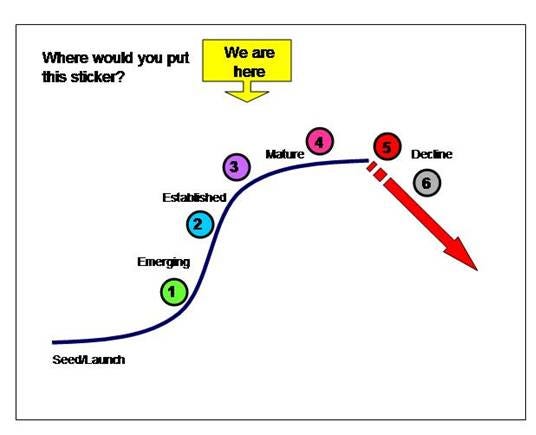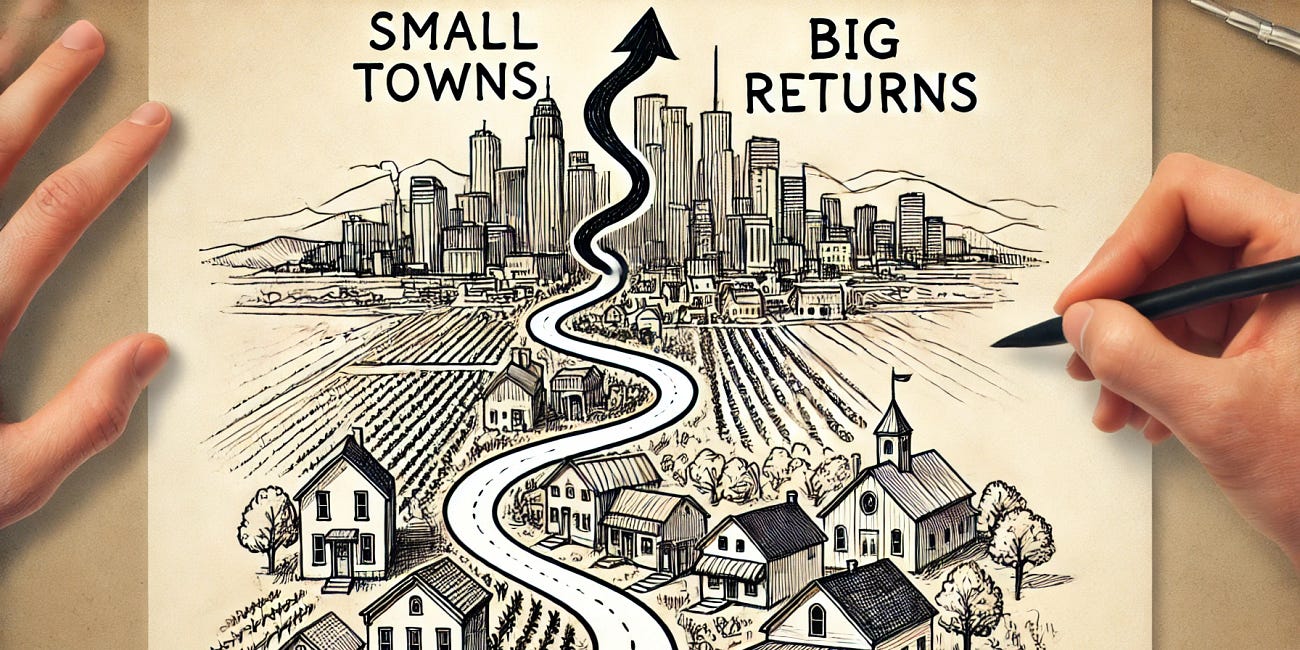Small Towns, Big Returns - Part IV
The Case for Investing in Smaller Communities: The S-Curve of Smart Growth
Imagine, instead of constantly pushing the limits of vertical growth in Halifax—taller buildings, denser populations, more strained infrastructure—we redirected our efforts toward something more sustainable, more human-scaled.
What if the answer to Halifax’s future prosperity didn’t lie in endless urban expansion but in investing in smaller communities, towns, and villages? This approach, driven by the principle that All Lines are Curves, could yield higher returns in terms of progress, prosperity, and purpose than the relentless pursuit of growth in already overcrowded urban centers.
Christopher Alexander’s book, The Timeless Way of Building became a cult favorite in the 1970s, offering a refreshing take on architecture that focused on creating spaces that feel alive, connected, and human. It introduced the idea that great buildings and towns grow organically, based on patterns that meet deep, universal needs. Alexander's philosophy cuts through the noise of high-rise urban development, suggesting that small towns—like those in Halifax—offer the best return on investment. They prioritize community, beauty, and a sense of place over the relentless chase for growth, delivering what people actually want: a rich, fulfilling quality of life over sheer expansion.
The book describes an elusive, almost spiritual essence that makes places, objects, and experiences feel profoundly right and alive. It’s that feeling of harmony, beauty, and timelessness you can’t quite put into words but instantly recognize when you encounter it—whether in a well-built home, a charming neighborhood, or a perfectly designed chair. Understanding this quality is shared by all people at all times - and even those who claim to reject it are rejecting their own self for complex reasons - means valuing simplicity, balance, and connection to nature. It’s important because, in a world focused on speed and growth, we risk losing the very qualities that make life feel meaningful and human. The Quality Without a Name reminds us that true beauty and order often transcend our ability to define them, but are vital to our happiness and well-being.
It’s not as whooo-hoo hippie as it may sound at first. Few among us know how the tides work, why we need sleep, what the ground is made of, or how the water cycle works, none know for sure how gravity works. But we all accept they are real things that define our lives and well-being.
The S-Curve of Urban Growth: When Bigger Isn’t Better
Urban development typically follows an S-shaped growth curve. In the early stages, growth is rapid, driven by the availability of land and resources. As cities expand, they attract more people, businesses, and capital, leading to a virtuous cycle of growth. But as the city becomes denser, the challenges multiply: infrastructure becomes strained, housing costs rise, and the quality of life begins to diminish. The care and feeding of cities depends on many complex factors. Not all cities are destined to be New York - which is fed by a river system that delivers the full economic output of America’s heartland to its streets, or Paris, which famously is one of the few cities in the world surrounded by so much bounty that it can feed itself within a 100-mile radius. Eventually, cities reach a natural saturation point given their geopolitical wealth and assets, where the returns on investment in further growth begin to diminish in the things that really matter to people.
Halifax is past this plateau. The high cost of living, increasingly congested infrastructure, and housing shortages suggest that the city is bumping up against its limits. Continuing to invest in urban growth—especially without addressing underlying issues like affordability and sustainability—may provide diminishing returns for both the government and residents.
On the other hand, smaller communities and towns throughout the vast municipality offer untapped potential for growth without the same downsides. They have been starved for investment - even of their own generated tax dollars - for almost 30 years. By investing in smaller towns, villages, and rural areas, we could activate a different part of the S-curve, one where growth yields higher returns for each dollar spent. These areas are underdeveloped and underutilized, meaning there is ample room for productive, sustainable growth.
The Hidden Value in Small Communities
Investing in small towns and rural areas isn’t just about reducing pressure on the city; it’s about amplifying opportunity. Smaller communities have a different growth trajectory. For decades, many have seen populations decline or stagnate as young people migrate to urban centers for jobs. But this presents an opportunity: with the right investment, these areas can become vibrant hubs of local culture, economy, and innovation.
Economic Return: The cost of developing basic infrastructure in smaller towns is significantly lower than in densely populated urban centers. A dollar invested in building new housing, improving public services, or creating local jobs in a rural town can stretch much further than in Halifax. Small towns are often cheaper to develop, and with fewer complications regarding land acquisition or zoning, development projects can be completed more efficiently and with fewer barriers. In the business, they call it Greenfield Development.
Cultural and Social Return: Small communities often have a stronger sense of identity and purpose, with a deep connection to local culture and history. Investments in these areas can strengthen community bonds, preserve historical sites, and create a renewed sense of belonging. In a time when urban centers risk losing their sense of identity in the pursuit of growth, smaller towns can offer a refreshing alternative where culture and community take precedence over corporate and urban sprawl.
Environmental Return: Developing smaller communities, particularly in rural areas, could also offer a more sustainable model for growth. Large cities generate enormous amounts of waste, pollution, and energy consumption, which strain both local and global ecosystems. By spreading growth across smaller areas, we reduce the environmental impact of overconcentration. Moreover, rural areas provide opportunities for green development, from sustainable agriculture to renewable energy projects, that would be impossible in an urban setting.
Right-Sizing for Prosperity: The Rural Advantage
The concept of right-sizing isn’t just about restraining growth in urban centers; it’s about redistributing opportunity. It’s about taking the time to plan and project the right amount of growth, in the right time, right place, and right way. Instead of focusing solely on Halifax’s vertical and outward growth, we should consider how smaller communities could become new nodes of economic activity.
The rise of remote work during the pandemic has shown that not all jobs need to be concentrated in cities. The dream of walking to work is not out of reach in well-planned towns and villages. Maybe the “regional office” of the 80’s can return in a smaller more human form. Many people can work just as efficiently from a small town as they can from a city high-rise. This shift opens the door for revitalizing rural communities, as people are no longer tied to urban centers for employment. Investing in basic and digital infrastructure—like high-speed internet in rural Nova Scotia—would allow professionals to live in smaller communities while maintaining their careers in larger, global markets.
Moreover, smaller towns often have untapped entrepreneurial potential. Lower overhead costs and a closer-knit community can create fertile ground for small businesses, local crafts, and niche industries. By investing in these areas, we create opportunities for local economies to thrive, which in turn strengthens the provincial economy as a whole.
The Return on Purpose: Meaningful Growth
One of the most overlooked aspects of relentless urban expansion is the impact it has on purpose. When cities grow without a clear vision, they risk becoming generic, soulless landscapes dominated by chain stores and impersonal high-rises. Small communities, by contrast, tend to retain their sense of place. Investing in smaller towns and rural areas isn’t just about economic return—it’s about creating spaces where people feel connected, where life is more than just the next development deal.
These areas are often more affordable, more livable, and more conducive to a balanced lifestyle—all of which contribute to a sense of purpose and belonging that cities often struggle to provide. Right-sizing isn’t just about physical development; it’s about building communities where people can thrive—where their individual contributions are valued and where the growth is measured in quality of life, not just GDP.
Small Towns, Big Returns
In the rush to expand urban and up, Halifax missed an opportunity to invest where the returns could be highest: in the smaller communities that dot the municipality - dozens or even hundreds of them. By shifting our focus from endless urban growth to sustainable rural development, we can ensure that Halifax thrives as a whole—creating progress, prosperity, and purpose for people across the region.
We can recognize when our current urban and up path is nearing its limit. No one who can imagine more and better is happy. We don’t need to continue with the same mistake just because it cost a lot of money and we spent a long time making it. We can pivot toward a strategy that promises more enduring success.
Smaller, well-supported communities may hold the key to Nova Scotia’s future, offering not only a higher return on investment but a more balanced, human-centered way of life.
Small Towns, Big Returns - Part I
This is the first in a multipart essay on the diminishing returns of growth in Canada’s nicest cities.








Wonderful article, John. Our future, if there is one, is rural. Thanks for mentioning Christopher Alexander-a man outside of his time and just the architectural point of view most needed now.
The Provincial government needs to seek a better tax distribution method with municipalities both to do better with the downloaded responsibilities they already have and to allow more functional autonomy to suit their constituents.
Municipalities need to look hard at their building codes to reduce barriers for folks wanting more diverse ways of living and building.